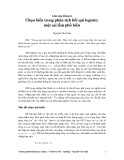
Vol. 7, 2020A new decade for social changeswww.techniumscience.com9772668779000ISSN 2668-7798

Factors affecting motivation of employees in public sector in
Erbil, Iraq an application of binary logistic regression
Amir Khaleel Hassoo1, Cuma Akbay2
Department of statistics, Soran University1, Department of Bioengineering and
Sciences, Kahramanmaraş, Turkey2
amir.hasoo@soran.edu.iq1, cumaadana@hotmail.com2
Abstract. Motivation is a general term that refers to the needs, demands, desires, or individual’s
internal forces. The main objective of this study is to investigate the factors affecting job
satisfaction and motivation of employees in the public sector in Erbil- Iraq. To achieve this
purpose, the researcher was required to get the questionnaire filled from employees working at
different organizations. Data were obtained from randomly 250 employees working at different
organizations and the questionnaire was distributed in 2019. A questionnaire was designed and
used to record information based on a 3-point Liker scale. Descriptive statistics and Binary
Logistic regression by using SPSS program analysis used. The results indicated that some factors
such as "education", "job status", "training and development", "justice" and "job security" have
an impact on motivating employees.
Keywords. Employee, motivation, Public Sector, Logistic Regression, Erbil, Iraq
Introduction
The concept of motivation and its parts, which stimulate us, is the most sophisticated parts of
psychology in today’s management. This requires a lot of effort and research to be done.
Humanitarian issues widen every day, despite the rapid advancement of technology (Egan et
al., 2004). The motivation for work has occupied experts’ minds widely. Research about
motivation’s phenomenon and its role in the person’s behavior undoubtedly refers to
psychological research (Bakay and Huang, 2010). There is no doubt that motivation plays a
huge role in activating the outcomes and achieving goals. Therefore, managers always face the
question of how to motivate employees and themselves. In every business, there are usually
three partners that organizations deal with. These partners are known as shareholders,
employees and customers. The leading partner that you face every day is that of your staff and
nobody elsewhere (Cherry, 2015). Several years ago, attempts made to understand the main
roots of managing mental change. This was for answering the puzzle of high quality at a low
price. One of the interesting and new points was that the evolved industrial and management of
Japan is rooted in the solving of the quality problem (Wright, 2007). The underlying problem
solving and quality control, human factors are considered. From this point of view, attention
should be paid to humans, and they should be handled appropriately in the workplace and
industrial site. More importantly, their diversity and different opinions must be taken into
consideration (Lewin et al., 2003). There is a theory which believes quality products and
321
Technium Social Sciences Journal
Vol. 7, 321-329, May 2020
ISSN: 2668-7798
www.techniumscience.com

services could achieve quality human. Thus, organizations and manager’s efforts should
initially focus on building quality humans. No attempt is going to be successful unless humanity
in the workplace takes into account. Surprisingly, Japanese experts are highly experienced and
qualified, still, when they ponder solving quality issues and an organization management
framework, their research and academic work does not overlook human behavior (Garg and
Rastogi, 2006). Human has not only to influence on industrial and commercial organizations
but also considered as the main factor in developing the purposes of the organization (Licht,
2010). To increase both productivity and efficiency, factors of motivation should be known.
Later on, for meeting the needs, more adequate steps must be taken. All management experts
believe that motivation is the most complicated aspect of nature (Danish and Usman, 2010).
This suggests that it is multidimensional. From this sense, understanding the factors requires
research and the way that is managed. Information about the employee’s motivation factors
which results in changing the way that employees behave and react (Arnett et al., 2002). There
are two job motivating factors that were seen by some researchers. These two variables are
separate as an intrinsic variable and an extrinsic variable (Vandenabeele, 2009). The inherent
variables contain, interesting work, promotion, feelings of involvement and career
development; also, the external variables are respectable salary, job security, good working
conditions and intellectual discipline (Curtis and Riva, 2009). Extrinsic according to motivation
tools of extrinsic motivation is incorporates such factors which are job security, promotions,
pay, the social climate and private office space (Mahaney and Lederer, 2006). Besides they
include merit bonuses, pay raises competitive salaries and such devious forms of payment as
compensatory time off and vacation and external to the job itself. Determinants of motivation
relying on literature, the motivation's meaning for employees are comprehensible (Berman et
al., 2010). The purpose of this study was to analyze the effective factors on job satisfaction and
motivation of employees in the public sector in Erbil-Iraq. In the study, not only socio-
demographic factors but also, the effect of some factors such as good communication between
managers and employees, offering organizational and professional development courses with a
variety of skills, providing educational opportunities to progress degree and achieve higher
administrative authority, incentives and organizational culture, physical aspects of working
conditions and reward on employees' job satisfaction and motivation will be investigated.
Methodology
To obtain the necessary data for the study, a questionnaire survey has been designed particularly
for this purpose collected through the employees of province Erbil, Iraq during 2019. Therefore,
the sample for the study consisted of 250 employees in the public sector. Data collected by
administering the research instrument were analyzed in line with each research question and
hypothesis. Descriptive statistics (such as frequencies and percentages) were used to answer the
research questions. Binary logistic regression was used to analyze the hypotheses. The SPSS
program was used to run all the a
nalyses for the study.
Logistic regression analysis
In order to analyze the data, the study used logistic regression that is a statistical method that is
used to analyze data. At the same time, logistic regression is very helpful in showing a binary
dependent variable. Meanwhile, it is also useful in describing the association between a binary
dependent variables and an independent or explanatory variable. Parameters attained for the
independent variables can be used to evaluate odds ratios for each of the independent variables
in the model (Long and Freese, 2006). The only difference between logistic regression and a
linear regression model is in results of variables. In the former the result is binary or
322
Technium Social Sciences Journal
Vol. 7, 321-329, May 2020
ISSN: 2668-7798
www.techniumscience.com

dichotomous. The variance between logistic and linear regression is reflected both in the opt of
a parametric model and in the expectations. This variance used to say in the analysis of logistic
regression follows the same rules of linear regression analysis. For any types of regression
analysis, the significant measure is the mean values of the result variable, given the values of
the independent variable as:
Ε(Y/ x) = β
0
+ β
1
x
Where Y signifies the result variable, Χ represents a value of the independent variable, and the
βi’s symbolize the model parameters. Many distribution functions have been proposed for use
in the analysis of a dichotomous outcome variable. The specific form of the logistic regression
model is (Hosmer and Lemeshow, 2013).:
π
(
Χ
)
=
=
e
For simplifying notes, we let π (Χ)=E (Y/ Χ). The transformation of π(Χ) logistic function is
identified as the logistic transformation:
g
(
x
)
=
β
+
β
x
The significance of this transformation is that g(Χ) has many of the needed properties
of a linear regression model. The logit, g(Χ) is linear in its parameters, may be continuous, and
may range from minus infinity to positive infinity, dependent on the range of Χ.
The method of linear regression is mostly used to estimate unknown parameters called
least squares. The values of parameters in this method select to diminish the sum of squared
deviations of the experimental values of Y from the modeled values. In linear regression the
method of least squares produces evaluators with a several desirable statistical properties.
When the method of least squares is used to a model with a dichotomous result the estimators
no longer have these same properties. The public method which leads to the squares function
under the linear regression model (when the error is normally distributed) is named the
maximum likelihood. This method offers the basis for assessing the parameters of a logistic
regression model. A brief review of fitting the logistic regression model is given below (Hosmer
and Lemeshow, 2000). It is invalid to originate the mathematical appearance of the statistic G.
Instead, it should be supposed that below the null hypothesis that is β1 equal to zero, G will
follow a chi-square distribution with 1 d.f. Another test statistic, similar to G for the purpose,
used in this study is known as Wald Statistic (W) which follows a standard normal distribution
under the null hypothesis that β1 = 0. This statistic is computed by distributing the assessed
value of the parameter by its standard error as:
W=
⋀
𝐩
𝟏
𝐒𝐞
(
⋀
𝐩𝟏
)
The likelihood ratio test is should be used in doubtful cases, it especially when Wald test fail to
reject at the time when coefficient was significant. A ratio of being used for two odds is called
the odds ratio (OR). The odds ratio is used to give us an idea of in what way powerfully a given
variable may be linked with the result of attention compared to other variables. For a possibility
of success p, the odds (likelihood) of success (in our case with cause of motivation, i.e.,
involved) are defined.
odds =
𝝅
𝟏
𝝅
Basically, odds are nonnegative values. While the odds are less than one, the possibility of
achievement is less than that of failure; when the odds equivalent one, the probabilities of
323
Technium Social Sciences Journal
Vol. 7, 321-329, May 2020
ISSN: 2668-7798
www.techniumscience.com

success and failure are equally likely; and when the odds are greater than one, the probability
of success is greater than that of failure (Hosmer and Lemeshow, 2000).
Results and discussion
Socio Demographic Characteristics of Respondents
The finding of the research showed that the percentage of male employees (59, 2%) is higher
than in females (40, 8%). As well as, the result of marital status portrayed that, nearly 55% of
the employees are married, and 45% are single (Table 1). Married employees generally have
more salary and benefits than single employees. On the other hand, 20% of the staff are
department managers, and 80% of respondents are working as staff employees. Besides, most
of the staff employees are continuing education to getting a higher degree and participate in
educational programs to have higher authority in their job. According to the result, 33% of the
respondents have degrees less than a high school, while the remained 67% is occupied by the
employees that have a degree of a diploma; bachelor or masters. Further, results indicated that
60.8% of the respondent‘s ages are less than 30 years old, and 39.2% are more than 30 years
old. Moreover, the table shows that the majority of employees are between 25 to 30 years old
which indicates that the youth have a very good opportunity to work in Erbil which has positive
results on performance since youth are more lively, technologically educated, multi-skilled and
less resistant to change (Mahmood, 2014). In addition, many employees earn a low salary,
because it‘s not a long time they became employed. Also, a small percentage of respondents
obtain a high salary because of long-time employees.
Table 1. Socio Demographic Characteristics of Respondents
Variables Frequency %
Gender of
respondents
Male
148
59.2
Female
102
40.8
Marital status of
respondents
Single
112
44.8
Married
138
55.2
Job status of
respondents
Manager staff
50
20
Employee staff 200 80
Education of
respondents
Primary
and secondary
29
11,6
High school
53
21
,
2
Diploma
52
20
,
8
University
116
4
6,4
Age of respondents
(years)
<25
43
17.2
25
-
30
109
43.6
>30
98
39.2
Household income
(1000 IQD)
<500
115
46.0
500
-
800
96
38.4
>800
39
15.6
4.2. Factors Affecting Job Satisfaction and Motivation
Moreover, the result illustrated that 13.6% of the employees selected disagree and increased to
50.8% agree about "I feel that my superior always recognizes the work done by me". Employees
always want their managers to officially identify their jobs. According to Table 4.2, 10.8% of
the employees chosen disagree and increased to 44.8% agree about "training and development
have a positive and significant effect on employee". Follow by it can find that both, learning
324
Technium Social Sciences Journal
Vol. 7, 321-329, May 2020
ISSN: 2668-7798
www.techniumscience.com

























![Quyển ghi Xác suất và Thống kê [chuẩn nhất]](https://cdn.tailieu.vn/images/document/thumbnail/2025/20251030/anh26012006/135x160/68811762164229.jpg)
